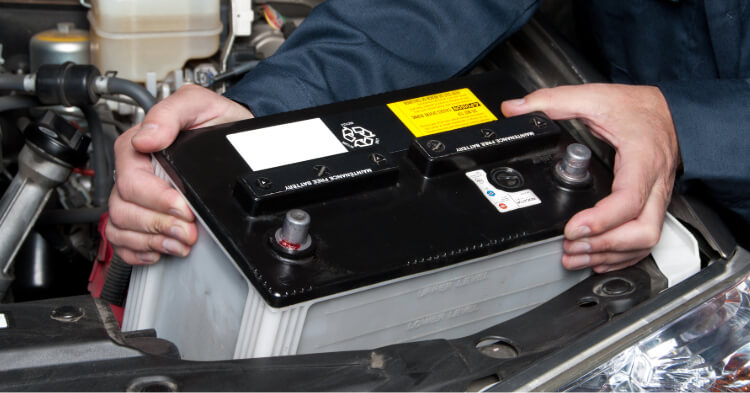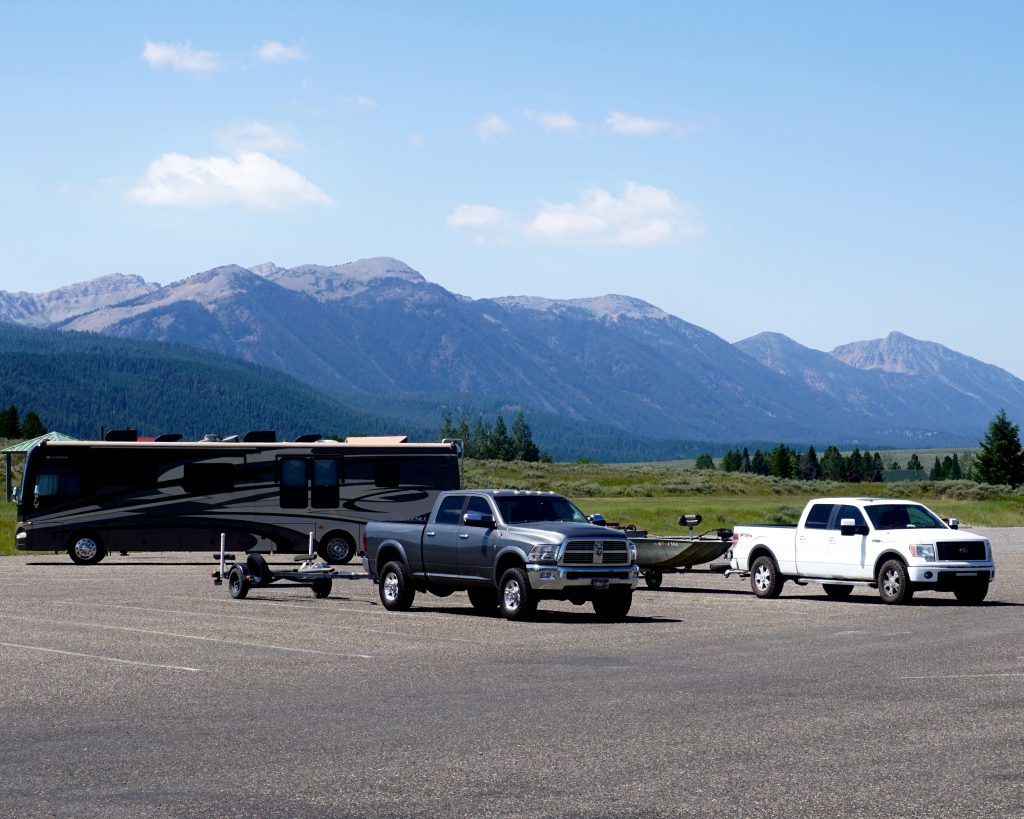Dealing with a dead car battery? Learn the top 5 things that are killing your car battery and how to prevent them. Our guide reveals the main reasons and simple steps to keep your battery reliable.

Whether it’s for work, play, or the occasional weekend adventure, towing capacity is a crucial aspect of owning a truck. But how much do you really know about your truck’s towing capacity?

The towing capacity of a vehicle is an important parameter that is specified by the manufacturer. It indicates the maximum allowable weight it can tow. Yet, this seemingly simple concept is influenced by a myriad of factors, including:
All of these factors play a part in determining how much weight your truck can safely tow.
How do these elements impact a truck’s towing capacity? Begin with understanding Gross Vehicle Weight Rating (GVWR) and Gross Combined Weight Rating (GCWR).
GVWR is your vehicle’s weight limit, as set by the manufacturer. It includes the weight of the vehicle, all its passengers, and any cargo. Think of it as the truck’s maximum allowable weight. This is critical for towing, as it denotes the maximum load capacity of a vehicle.
It’s much like a backpacker balancing their pack. Just as a hiker must consider the weight of their gear to avoid straining their back, a truck driver must consider GVWR to avoid straining their truck.
While GVWR considers the weight of the vehicle and everything in it, GCWR goes a step further. It’s the maximum permissible weight of both the laden tow vehicle and the loaded trailer. Imagine being the aforementioned backpacker, but now you’re also pulling a sled filled with additional gear. That’s what GCWR accounts for.
When towing, you must stay within the specified GCWR to maintain safety and prevent vehicle damage.
Now that we’ve tackled GVWR and GCWR, let’s focus on tow vehicle ratings, also known as tow rating. Established by the manufacturer, they denote the maximum weight that the vehicle can safely tow. Just like an athlete training for a marathon, manufacturers calculate tow vehicle ratings based on a variety of factors, including strength, design, and weight. They test the vehicles extensively to ensure they’re up to the task, just as our marathoner would train for the big race.
These ratings, also known as max tow rating, are vital for a successful and safe max towing experience, as going beyond them can stress the truck’s components and compromise road safety.
With GVWR, GCWR, and tow vehicle ratings clarified, you can now learn more about other important towing terms. Understanding these terms is akin to learning a new language. Just as a traveler learns key phrases to navigate a foreign country, understanding these essential terms will help you navigate your towing journey with confidence.

First up is maximum towing capacity. This is the highest weight a vehicle can tow, as specified by the manufacturer. It’s like the maximum weight limit on an elevator. An elevator might be able to hold a certain number of people, but if it’s loaded with heavy luggage, it can’t carry as many passengers. Likewise, a truck’s max towing capacity takes into account the weight of the truck itself, along with any cargo it’s carrying.
Next, we have tongue weight. This is the downward force exerted on the hitch ball by the trailer. Picture a seesaw. If both sides are evenly weighted, it balances perfectly. But if one side is heavier, it tilts.
Tongue weight is all about maintaining that balance to prevent swaying or instability while towing.
Finally, it’s crucial to understand the difference between payload and towing capacity. Payload denotes the weight a vehicle can carry, while towing capacity denotes the weight it can tow. It’s like the difference between what you can carry in your backpack versus what you can pull in a wagon. Both are important capabilities, but they serve different purposes.
Equipped with a clear understanding of towing capacity and its determining factors, you are now prepared to choose the appropriate truck for your towing needs. But how do you choose the perfect fit?
Let’s consider the differences between compact trucks and full-size pickups, and when more weight demands more power.
Compact trucks and full-size pickup trucks each have their unique perks, much like choosing between a cozy city apartment and a spacious suburban home. Compact trucks are smaller, more fuel-efficient, and generally cheaper. However, full-size pickups offer greater towing capacity and power.
The choice ultimately depends on your specific needs and preferences.
Sometimes, you need a bit more muscle. That’s where heavy-duty haulers come in. These trucks, with their powerful truck bed, are designed for towing larger loads and offer increased power and capability. They’re like the heavy lifters in a moving crew, capable of handling the bulky, heavy items that the rest can’t.
Similar to a chef needing the right utensils for a culinary masterpiece, towing necessitates the correct accessories and upgrades. From trailer tow packages that maximize your truck’s towing capability to gooseneck hitches that unlock additional towing power, let’s explore the tools of the trade.
A trailer tow package is like a chef’s special set of knives. It’s designed to enhance your vehicle’s towing capability through features such as:
These packages come with a variety of features that help stabilize the load, increase towing capacity, and improve overall towing performance.
A gooseneck hitch is like a sturdy handle on a heavy pot, providing additional towing power by distributing weight more evenly and allowing for tighter turning angles.
This type of hitch enhances towing capacity by providing a more secure and stable connection between the truck and the trailer.
Having covered the theory, we can now discuss practice. Much like a race car driver needs to know the track, a tower needs to know the ins and outs of their vehicle, trailer, and route to ensure a safe and efficient journey.
The first step to a successful conventional towing journey is proper vehicle loading. This ensures balanced towing and prevents issues such as trailer sway and poor handling. It’s like packing a suitcase for a trip. You wouldn’t want all your heavy items on one side, causing the suitcase to tip over.
Similarly, proper trailer weight distribution in both your vehicle and your trailer ensures a smoother ride.
Just as a hiker wouldn’t venture into the wilderness without the right gear, a tower must ensure their truck is properly equipped for the task at hand. This means having the right hitch, the right wiring, and the right towing accessories. It’s all about being prepared for the journey ahead.
Equally important is regular maintenance. Just like you wouldn’t run a marathon without proper training, you shouldn’t tow without ensuring your vehicle is in top shape. Regular maintenance checks, such as checking tire pressure and brake function, are essential for towing readiness.
Having covered the basics, we can now compare some popular truck models. Just like comparing athletes based on their personal bests, we’ll compare these trucks based on their maximum towing capacities.
Certain trucks excel in terms of towing capacity. Let’s look at the heavy hitters: the Ford F-150, Ram 1500, and Chevrolet Silverado 1500. These trucks boast the highest towing capacities, making them the MVPs of the towing world.
But towing capacity isn’t everything. Just like an athlete needs to balance their training with rest and recovery, truck owners need to balance their towing power with everyday use.
Factors such as fuel efficiency, ride comfort, and overall versatility can’t be overlooked.
In the world of towing, knowledge is power. From understanding key terms to selecting the right truck and accessories, each step of the journey plays a vital role in ensuring safe and efficient towing. Whether you’re a seasoned pro or a towing novice, this guide provides the insights you need to maximize your haul.
To find your truck’s towing capacity, check the owner’s manual or subtract your truck’s curb weight from its Gross Combined Vehicle Weight Rating (GCVWR). This GCVWR is the maximum weight of your loaded truck and trailer combined.
The truck with the highest towing capacity for 2023 is the Ford F-250 Super Duty, offering a maximum of 37,000 lbs. This model stands out among other options for its impressive strength and reliability.
Yes, the RAM 1500 is capable of towing up to 12,750 lbs. with its V8 HEMI engine, easily surpassing the 10,000 lbs. mark.
GVWR is the maximum weight a vehicle can carry, including passengers, cargo, and itself, while GCWR is the total weight of the vehicle and trailer, including cargo and passengers.
Tongue weight is the downward force exerted by a trailer on a hitch and it is important for vehicle stability and control during towing.

Dealing with a dead car battery? Learn the top 5 things that are killing your car battery and how to prevent them. Our guide reveals the main reasons and simple steps to keep your battery reliable.

If you’ve ever purchased a vehicle, you’ve likely been offered a warranty. But between the sales pitch and the fine print, it can be difficult to determine if these protection plans are actually worth your money. This guide breaks down everything you need to know about car warranties to help you make an informed decision.

Winter driving presents unique challenges, and staying safe on the road requires updated knowledge and preparation. This guide will cover vehicle preparation, driving skills, and essential safety measures. Equip yourself with these tips to navigate snow and ice confidently and safely.

Choosing between AWD and 4WD depends on your driving needs. AWD continuously powers all wheels, making it suitable for urban and diverse conditions. 4WD powers all wheels only when needed, ideal for off-roading. This article will explore AWD vs 4WD differences to help you decide the best option.

Manual or automatic is a crucial decision that can significantly impact your driving experience. So, let’s put the pedal to the metal and navigate the winding road of this manual or automatic transmission tussle.
